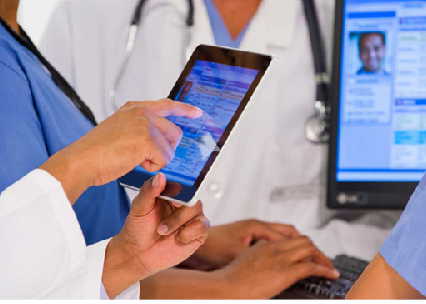The incorporation of new technologies in the healthcare system has been an innovative game changer. In this piece, PATIENCE IVIE IHEJIRIKA writes on how these innovations are helping to cut down errors, cost and increase precision in healthcare delivery.
At 86, Madam Justina Nwakerendu is down with arthritis and hypertension- common age-related sickness. She lives in Owerri, the Imo State capital with one of her children who alongside his wife and children are nursing her in her old age.
In this part of the world, old peoples’ care homes are not fashionable – children live with their aged parents and care for them.
However, the challenge with Madam Justina is that she is on wheelchair support which makes her care more daunting. Hospital routine visits will require her being lifted like a weight into a motor vehicle.
She said that it was in one of the hospital visits that the doctor introduced her to a telehealth platform called Doctorcare247.
The platform offers immediate access to medical care for both young and old from the comfort of people’s homes, offices or even on the go. It has the added advantage of removing long waits in hospitals and giving prompt help in cases of emergencies.
“That is perhaps why I am still alive to tell you this story today because I would probably have died during the nationwide coronavirus lockdown period,” Justina said.
Before the pandemic, the use of telemedicine for primary care appointments was rare. The technology was mostly reserved for urgent care visits. But with the onset of the pandemic in March 2020, telemedicine offered most of the care being delivered, particularly during the mandated shutdowns across Nigeria.
Experiences during this COVID-19 period have shown that patients experienced boosts in access to care through the increased availability of telemedicine.
A study reports that post-discharge primary care visit completion rates climbed from 62 percent to 72 percent from January to June 2020.
The chief executive officer of Doctorcare247, Chucks Chibundu, suggests that one of the reasons telemedicine may be closing some of the health gaps is because it makes appointments more convenient and brings care closer to where a patient is.
“Physically travelling to a clinic, taking time off work – particularly when you’re recovering from a recent hospitalisation – are just some of the many difficulties that present barriers for patients to follow-up care,” he said.
Doctorcare247 hopes to bridge the gap between patients requiring immediate, easily accessible, affordable medical attention and healthcare professionals and specialists who provide healthcare services by removing onerous challenges of healthcare access, meeting need for urgency, convenience, and most importantly, flexibility of time.
It gives patients the freedom to dictate the quality of healthcare received and deliver 24/7/365 unparalleled quality, convenient and affordable healthcare on demand.
With telemedicine, the crowd presenting at the hospital for care reduces patient contact with each other which in turn helps to curb the spread of infection, most especially for patients with reduced immunity.
Ultimately, the experience of administering remote care in a person’s home environment rather than the traditional doctor’s office or hospital creates some positive gains.
“It’s so valuable to see patients at home in their environment because we never really have that opportunity to interact with a patient in that way, where perhaps they’re a bit more comfortable. And you can actually see how they take their medications every day, what the home environment looks like. All of that gives you such a richer picture potentially of a patient’s health than an office visit,” the chief operating officer of Doctorcare247, Dr Uche Agu said.
Telemedicine comes with many opportunities and Doctorcare247 is racing to meet up with the challenges. While initially it just offered general medical consultations, Doctorcare247 soon developed so that patients could also access specialist care and have now added a nurse, physiotherapist, dietitian, or other allied healthcare professionals online.
And as the service evolved, a platform was then built that created an individual health record for each client, one they could access as well as the doctors.
“This is very different to the way normal practices work – they store our health records, but you don’t have access to it. With this system, it allows the patient to take control as they will always have access to their health records. Not only can they see the information we store on them, such as medication and their past medical and surgical history, but they also have the opportunity to upload their own information and store it there as well,” Chibundu said.
Doctorcare247 offers a range of other services, from at-home STI testing to dermatology consultations, and unsurprisingly, demand for their services has surged since the pandemic began.
“It’s naturally increasing as people become aware of their ability to do some of these things from the comfort of their own home – when you are working, it is difficult to get time off during the day,” Chibundu said.
Governments and charities are taking advantage of telehealth as an effective method of accessing patients from rural and other underserved localities, as long as the infrastructure is available.
Overall patient feedback has been favourable, suggesting patient satisfaction and a high level of acceptance, especially given the savings in travel expenses and time.
According to a user in Lagos, Bisi Kehinde, “video visits offer quality medical care – from the comfort of your home. For many patients, going for a medical checkup isn’t a big deal. But at age 92, I found that trips to the doctor were becoming more and more challenging. Navigating my appointments has been equally stressful for my daughter. But Doctorcare247 has been of tremendous help since we started using the service.”
Telemedicine has also proved very useful in several medical specialties where the combination of real-time image and sound can replace physical presence. These include telepathology, teleradiology, teledermatology, telepsychiatry, telepharmacy and telesurgery.
Some examples of success in telemedicine have been seen in the fields of dermatology and psychiatry. Several small-scale studies exhibit the advantages of telemedicine interventions in the management of chronic disease. Studies show that telemedicine in office – and hospital-based settings is most beneficial for specialties requiring greater verbal communication in diagnosis and treatment, such as in psychiatry and neurology.
Of note are recent success stories in advanced therapy contexts. For example, in Singapore, telemedicine throughout the COVID-19 pandemic enabled patients to undergo selective internal radiation therapy. This included guaranteeing a continued supply chain, dose verification, and administration of the dose conjointly with the interventional radiologist.
Telemedicine tools also offer considerable opportunities to bring high-quality medical care to scenarios where it is not readily available on site. These include Internally Displaced Persons (IDPs’) camps, prison facilities, remote dwellers and rural areas in developed and developing countries.
Video visits and secure messaging can be effective tools to remotely monitor and treat patients with mild symptoms who are staying at home. For instance, providers are able to remotely monitor a patient’s temperature and symptoms and determine if the patient can safely stay at home or should seek in-person care. In Lagos, Doctorcare247 is working with hospitals to provide remote monitoring tools and enables the hospitals to monitor patients at home.
Granted, rapidly expanding the use of telemedicine may take time to establish the necessary technology infrastructure, recruit providers to provide care virtually, provide training on best practices, educate patients about telehealth and negotiate coverage with payors. While it poses initial technology challenges, such initial setbacks are dwarfed when put alongside the benefits users enjoy. For example, with as low as N500 a patient can get assistance with medical care ranging from skin conditions to diarrhoea and stomach disorder and eye irritations – conjunctivitis.
From the cost of transport to the hospital to consultation and many more, telemedicine eliminates these costs for users. Studies have shown that there is up to 30 percent savings from healthcare costs when using telemedicine.





